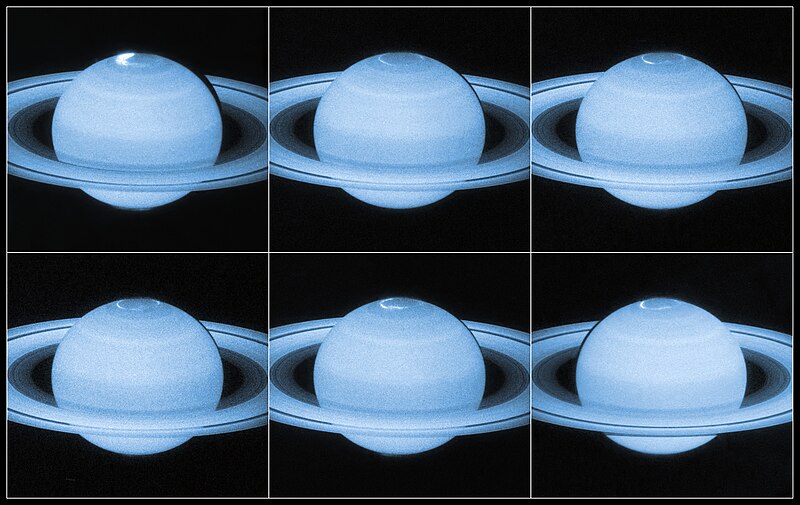Datei:Hubble sees a flickering light display on Saturn.jpg

Originaldatei (3.519 × 2.222 Pixel, Dateigröße: 2,22 MB, MIME-Typ: image/jpeg)
![]()
Diese Datei und die Informationen unter dem roten Trennstrich werden aus dem zentralen Medienarchiv Wikimedia Commons eingebunden.
Beschreibung
| BeschreibungHubble sees a flickering light display on Saturn.jpg |
English: Astronomers using the NASA/ESA Hubble Space Telescope have captured new images of the dancing auroral lights at Saturn’s north pole. Taken from Hubble’s perspective in orbit around the Earth, these images provide a detailed look at Saturn’s stormy aurorae — revealing previously unseen dynamics in the choreography of the auroral glow.
The cause of the changing patterns in Saturn's aurorae is an ongoing mystery in planetary science. These ultraviolet images, taken by Hubble’s super-sensitive Advanced Camera for Surveys, add new insight by capturing moments when Saturn’s magnetic field is affected by bursts of particles streaming out from the Sun. Saturn has a long, comet-like magnetic tail known as a magnetotail — as do Mercury, Jupiter, Uranus, Neptune and Earth [1]. This magnetotail is present around planets that have a magnetic field, caused by a rotating core of magnetic elements. It appears that when bursts of particles from the Sun hit Saturn, the planet’s magnetotail collapses and later reconfigures itself, an event that is reflected in the dynamics of its aurorae. Some of the bursts of light seen shooting around Saturn’s polar regions travelled at over three times faster than the speed of the gas giant’s rotation! The new images also formed part of a joint observing campaign between Hubble and NASA's Cassini spacecraft, which is currently in orbit around Saturn itself. Between them, the two spacecraft managed to capture a 360-degree view of the planet’s aurorae at both the north and south poles. Cassini also used optical imaging to delve into the rainbow of colours seen in Saturn’s light shows. On Earth, we see green curtains of light with flaming scarlet tops. Cassini’s imaging cameras reveal similar auroral veils on Saturn, that are red at the bottom and violet at the top. Notes [1]A magnetosphere is the area of space around an astronomical object in which charged particles are controlled by that object’s magnetic field. The magnetosphere is compressed on the side of the sun, and on the other side it extends far beyond the object. It is this extended region of the magnetosphere that is known as the magnetotail. |
| Datum | |
| Quelle | http://www.spacetelescope.org/images/potw1420a/ |
| Urheber |
NASA, ESA Acknowledgement: J. Nichols (University of Leicester) |
Lizenz
| ESA/Hubble images, videos and web texts are released by the ESA under the Creative Commons Attribution 4.0 International license and may on a non-exclusive basis be reproduced without fee provided they are clearly and visibly credited. Detailed conditions are below; see the ESA copyright statement for full information. For images created by NASA or on the hubblesite.org website, or for ESA/Hubble images on the esahubble.org site before 2009, use the {{PD-Hubble}} tag.
Conditions:
Notes:
|
- Dieses Werk darf von dir
- verbreitet werden – vervielfältigt, verbreitet und öffentlich zugänglich gemacht werden
- neu zusammengestellt werden – abgewandelt und bearbeitet werden
- Zu den folgenden Bedingungen:
- Namensnennung – Du musst angemessene Urheber- und Rechteangaben machen, einen Link zur Lizenz beifügen und angeben, ob Änderungen vorgenommen wurden. Diese Angaben dürfen in jeder angemessenen Art und Weise gemacht werden, allerdings nicht so, dass der Eindruck entsteht, der Lizenzgeber unterstütze gerade dich oder deine Nutzung besonders.
Kurzbeschreibungen
In dieser Datei abgebildete Objekte
Motiv
image/jpeg
Dateiversionen
Klicke auf einen Zeitpunkt, um diese Version zu laden.
| Version vom | Vorschaubild | Maße | Benutzer | Kommentar | |
|---|---|---|---|---|---|
| aktuell | 03:30, 20. Mai 2014 |  | 3.519 × 2.222 (2,22 MB) | Jmencisom | User created page with UploadWizard |
Dateiverwendung
Keine Seiten verwenden diese Datei.
Globale Dateiverwendung
Die nachfolgenden anderen Wikis verwenden diese Datei:
- Verwendung auf en.wikipedia.org
- Verwendung auf en.wikiversity.org
- Verwendung auf eu.wikipedia.org
- Verwendung auf hr.wikipedia.org
- Verwendung auf id.wikipedia.org
- Verwendung auf mk.wikipedia.org
- Verwendung auf ro.wikipedia.org
Metadaten
Diese Datei enthält weitere Informationen (beispielsweise Exif-Metadaten), die in der Regel von der Digitalkamera oder dem verwendeten Scanner stammen. Durch nachträgliche Bearbeitung der Originaldatei können einige Details verändert worden sein.
| Namensnennung/Veröffentlicher | NASA, ESA Acknowledgement: J. Nichols (University of Leicester) |
|---|---|
| Quelle | ESA/Hubble |
| Kurztitel |
|
| Bildtitel |
|
| Nutzungsbedingungen |
|
| Erfassungszeitpunkt | 10:00, 19. Mai 2014 |
| Software | Adobe Photoshop CS6 (Windows) |
| Eindeutige Kennung des ursprünglichen Dokuments | xmp.did:e419b9aa-c82c-7d48-8680-ac3942973ca4 |
| Stichwörter | Saturn |
| Kontaktinformationen |
http://www.spacetelescope.org/ Karl-Schwarzschild-Strasse 2 Garching bei München, , D-85748 Germany |

